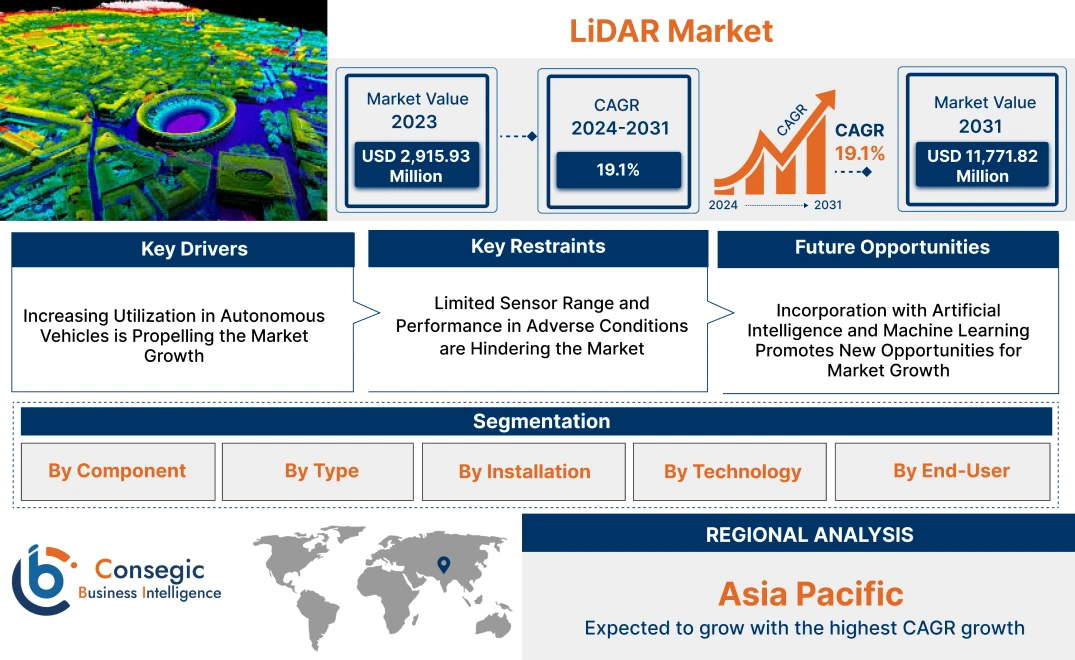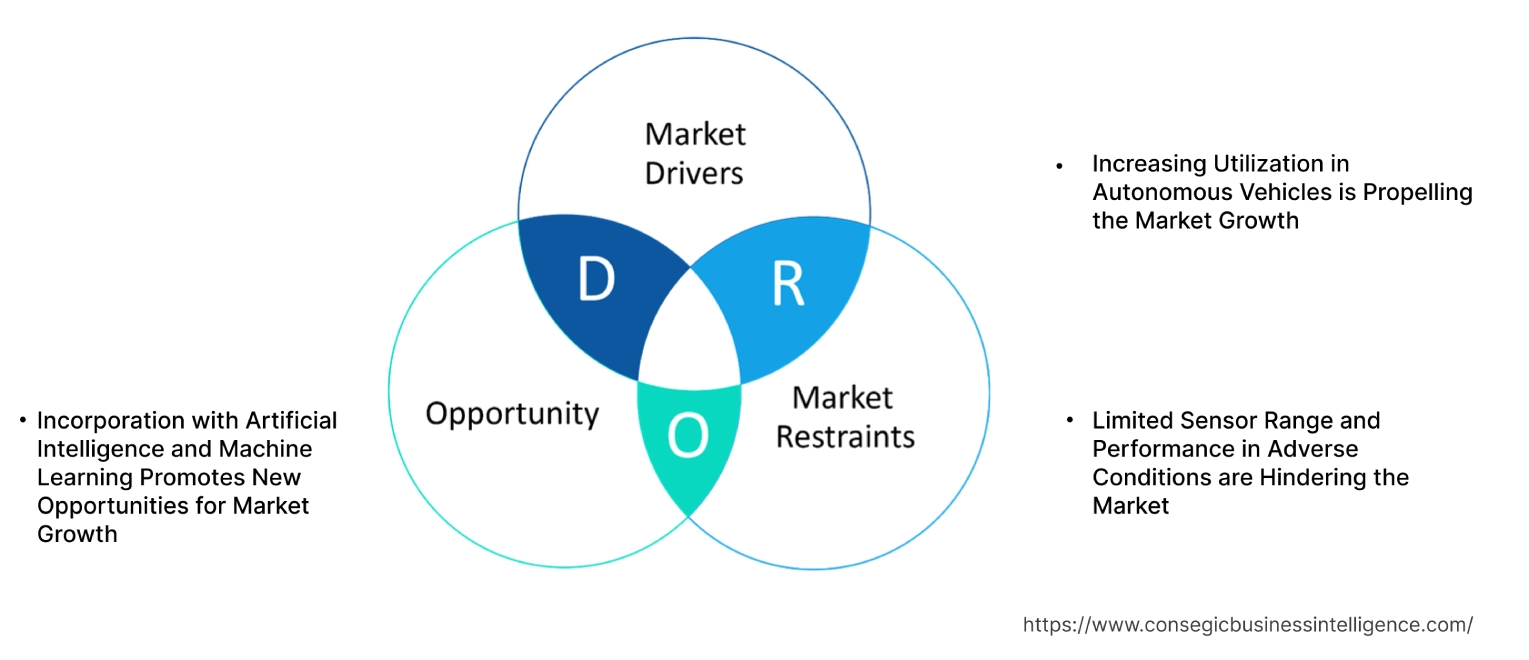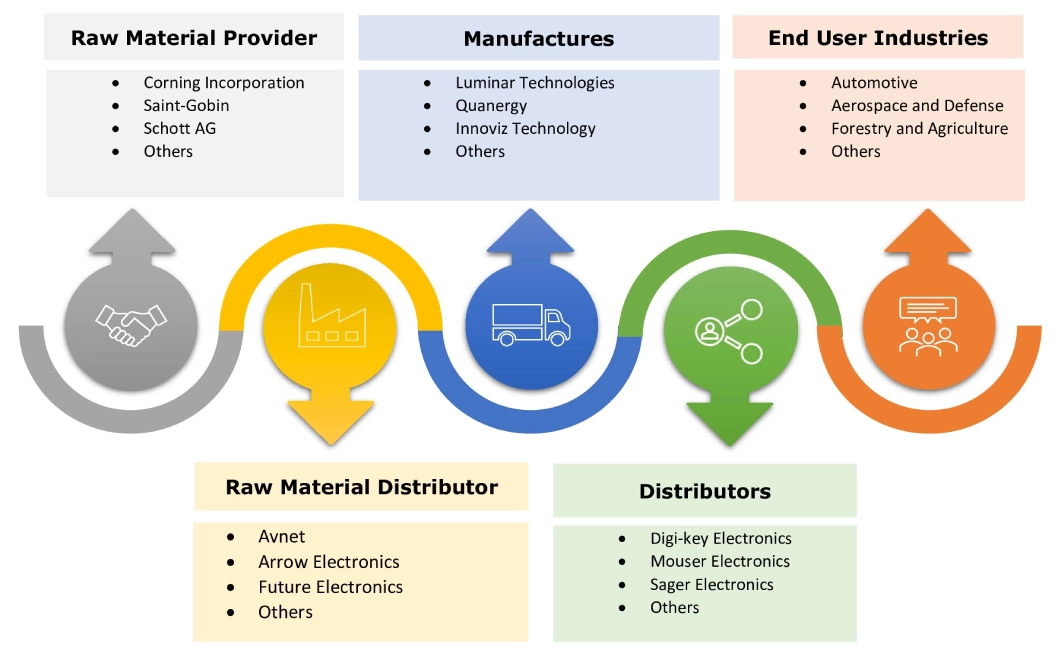- Summary
- Table Of Content
- Methodology
LiDAR Market Size:
LiDAR Market size is estimated to reach over USD 11,771.82 Million by 2031 from a value of USD 2,915.93 Million in 2023 and is projected to grow by USD 3,419.68 Million in 2024, growing at a CAGR of 19.1% from 2024 to 2031.
LiDAR Market Scope & Overview:
LiDAR is an acronym for Light Detection and Ranging is an optical remote sensing technology used to measure distances between objects with high precision. It operates by emitting rapid pulses of laser light toward a target. When these laser pulses hit an object, they bounce back to the sensor. By measuring the time, it takes for the light to return, Li-DAR calculates the distance between the sensor and the object. Additionally, it plays a crucial role in detecting obstacles, pedestrians, and road conditions, enhancing navigation and safety. Moreover, it is used to produce detailed topographic maps and models for urban planning, construction, and environmental monitoring. Furthermore, it can deliver high-resolution spatial data making it a powerful tool for improving precision and efficiency in numerous fields. The aforementioned features of Li-DAR are major determinants for increasing their deployment in automotive, aerospace and defense, agriculture, mining, and other industries.
LiDAR Market Insights:
Key Drivers:
Increasing Utilization in Autonomous Vehicles is Propelling the Market Growth
As there is growing demand for autonomous vehicles, self-driving technology relies heavily on Li-DAR for accurate obstacle detection and navigation. It provides autonomous vehicles with high-resolution, three-dimensional maps of their surroundings, enabling precise detection of obstacles including pedestrians, other vehicles, and road conditions. Additionally, this capability enhances the vehicle's ability to navigate through various driving conditions, including dense traffic, adverse weather, and complex road layouts, improving overall safety. Furthermore, advancements in Li-DAR technology are enhancing its integration into both fully autonomous and semi-autonomous vehicles. Innovations such as solid-state Li-DAR systems are making the technology more compact, affordable, and efficient, driving its adoption across the automotive industry.
- In May 2023, Ouster, Inc. signed a contract with May Mobility. This agreement aimed at providing Ouster's Li-DAR sensors to the autonomous vehicle solution of May Mobility. This sensor delivers long-range detection, increased safety, and high performance with 360-degree coverage for their autonomous vehicles.
Therefore, the increasing focus on autonomous vehicles is fueling the global LiDAR market growth.
Key Restraints :
Limited Sensor Range and Performance in Adverse Conditions are Hindering the Market
Li-DAR technology, while highly effective in many scenarios, faces limitations in sensor range and performance when operating under adverse environmental conditions. Factors including heavy rain, fog, snow, or dust can significantly impair the laser pulses emitted by Li-DAR systems. These environmental elements scatter or absorb the laser light, reducing the system's ability to accurately detect and measure objects, which compromises the quality of the data collected. Additionally, the reduced effectiveness of Li-DAR in such conditions necessitates the integration of complementary sensors, like cameras or radar, to provide a more comprehensive view of the environment. This adds complexity and cost to the overall system. Addressing these performance challenges requires ongoing research and development to improve li-dar technology's resilience and adaptability, which could help mitigate these issues and enhance its reliability across diverse operating conditions. Hence, limited sensor range and inability to perform in adverse conditions, are restraining the LiDAR market demand.
Future Opportunities :
Incorporation with Artificial Intelligence and Machine Learning Promotes New Opportunities for Market Growth
AI and machine learning greatly improve the processing and analysis of the vast amounts of data generated by Li-DAR systems. Advanced algorithms can interpret complex data more efficiently, leading to better object recognition, classification, and decision-making in real-time applications. Additionally, by leveraging AI, Li-DAR systems can enhance their accuracy and reliability. Machine learning models can adapt and improve over time, providing more precise data and reducing the impact of errors or inaccuracies in challenging environments. Moreover, in autonomous vehicles, AI-enhanced Li-DAR improves navigation and safety features, enhances data processing, and improves accuracy and reliability.
- In November 2021, Luminar Technologies, Inc. partnered with NVIDIA to leverage AI for processing Li-DAR data in real time. This collaboration aims to advance autonomous driving technology by using NVIDIA's AI platform to enhance data interpretation and decision-making capabilities. This long-range Li-DAR solution sensor suite helps to deliver safe, highly assisted, and full self-driving capabilities.
Overall, the integration of AI and machine learning with Li-DAR technology enhances the capabilities, expands its application, and drives significant expansion in LiDAR market opportunities.
LiDAR Market Segmental Analysis :
By Component:
Based on components, the market is trifurcated into hardware, software, and service.
Trends in the Component:
- There is an increasing trend for real-time data processing capabilities in Li-DAR software. Advanced algorithms and processing power are being developed to handle data streams from sensors in real time, which is critical for applications requiring immediate feedback and response.
- There is a growing trend towards miniaturizing Li-DAR systems and developing solid-state sensors. Solid-state Li-DAR eliminates moving parts, making the sensors more durable and cost-effective.
The hardware component accounted for the largest revenue share of 53.29% in 2023.
- Hardware component consists of laser scanners, IMU (inertial measurement units), cameras, GPS/SNSS receivers, MEMS (micro-electro-mechanical systems), and others.
- These hardware components work in concert to enable Li-DAR systems to measure distances accurately and create detailed spatial data.
- Factors of dominance include advanced sensors, improvements in wavelength and range capabilities, and applicability across various industries.
- In October 2022, Ouster, Inc. unveiled REV7 Sensors with enhanced range. It features the OSDome Li-DAR sensor series that delivers improved object detection, increased precision, accuracy, and greater reliability. The sensor is designed for various applications, including autonomous vehicles and robotics, offering a robust hardware solution for accurate 3D mapping.
- Thus, the applicability of hardware components across various industries is propelling the LiDAR market share.
The software component is anticipated to register the fastest CAGR during the forecast period.
- Software components in Li-DAR include tools for data processing, analysis, visualization, and integration with other systems.
- It handles dynamic data streams from sensors, providing immediate insights and improving operational efficiency.
- Additionally, cloud-based Li-DAR software solutions enable users to process, store, and analyze large datasets without the need for extensive on-premises infrastructure, offering scalability.
- In September 2021, Applanix introduced term licenses with maintenance and support for POSPac Mobile Mapping Suite (POSPac MMS) and POSPac Uncrewed Aerial Vehicles (POSPac UAV), desktop post-processing software. The POSPac PP-RTX for UAV is a cloud-based solution for data integration, georeferencing, and 3D modeling, enhancing aerial surveying and mapping applications.
- Hence, the software segment's importance in data analysis and real-time processing is expected to increase LiDAR market growth.
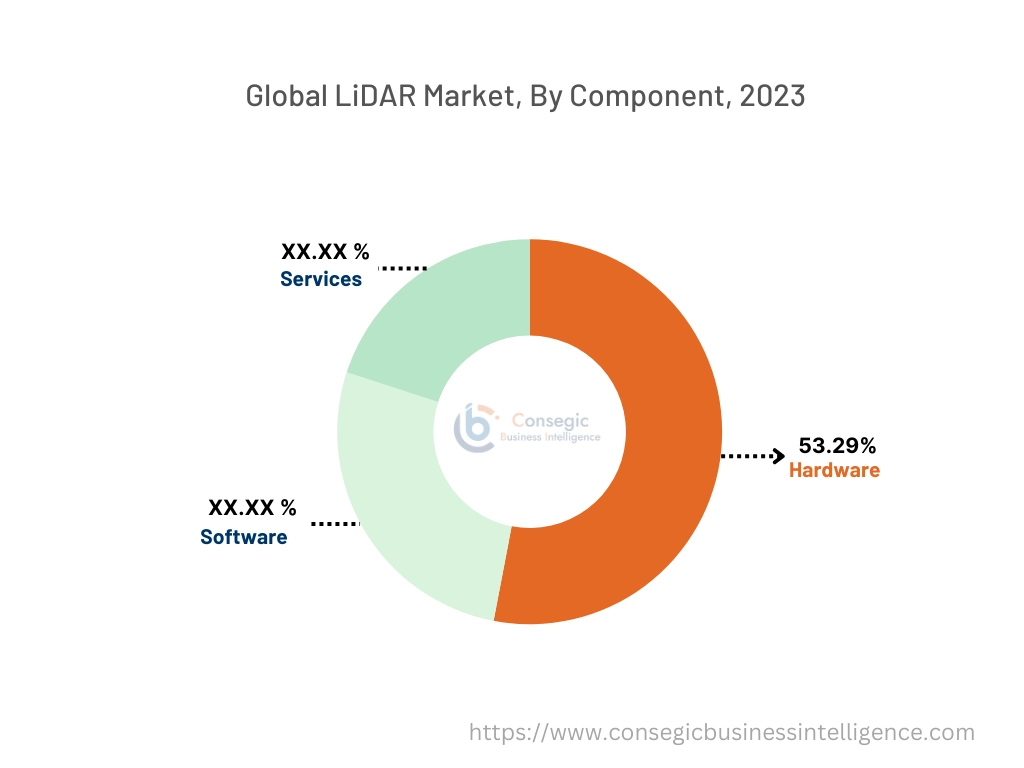
By Type:
Based on type, the market is segmented into mechanical, solid-state, flash, and others.
Trends in the Type:
- The tendency towards enhanced data processing capabilities in flash Li-DAR systems is enabling faster and more accurate analysis of the captured data. This is crucial for applications that demand rapid decision-making.
- Solid-state Li-DAR is becoming more popular in the automotive industry due to its reliability and compact design. It is increasingly used in autonomous vehicles and advanced driver-assistance systems (ADAS) for its durability and cost-effectiveness.
The mechanical accounted for the largest revenue share in the year 2023.
- Mechanical Li-DAR is a type of Li-DAR system that uses rotating or oscillating mirrors to scan the environment, capturing detailed 3D spatial data over a wide field of view.
- It is known for its high precision and long-range capabilities, making it suitable for applications such as autonomous vehicles and surveying.
- In December 2023, LSLIDAR unveiled PoE Series Mechanical Li-DAR including C32-PoE, C32W-PoE, and CH32R-PoE models. These models offer a detection range of up to 150 meters away, high precision, flexibility, and ease of installation. It provides high speed, 360-degree view, 3D scanning, and measurement accuracy.
- Consequently, due to high performance, accuracy and versatility mechanical type lead the global LiDAR market trend.
The solid state is anticipated to register the fastest CAGR during the forecast period.
- Solid-state Li-DAR technology eliminates moving parts, allowing for more compact and lightweight sensors.
- This design makes it ideal for integration into a wide range of devices, including autonomous vehicles and consumer electronics.
- It offers compact design, durability, reliability, and integration with advanced driver-assistance systems (ADAS) and smart city infrastructure.
- In September 2022, Innoviz Technologies and Sensagrate launched a joint smart intersection corridor pilot at UCLA. This collaboration aimed at integrating InnovizOne solid-state Li-DARs with SensaVision, a computer vision platform, and is fusing them with data from radar and camera sensors to create a smart corridor at an intersection at the UCLA campus.
- Overall, solid-state Li-DAR's advantages in magnitude, durability, and cost are expected to drive its dominance in the future LiDAR market.
By Installation:
Based on installation, the market is segmented into airborne, ground-based, spaceborne, and others.
Trends in the Installation:
- The integration of Li-DAR with unmanned aerial vehicles (UAVs) or drones is becoming more prevalent. Drones equipped with Li-DAR systems offer a cost-effective solution for capturing high-resolution data over large areas with greater flexibility and reduced operational costs.
- There is a trend towards collaborative space missions involving multiple countries and organizations. These collaborations enhance the capability and coverage of spaceborne Li-DAR systems, promoting international research and data sharing.
- Hybrid Li-DAR systems that combine various installation types or integrate with other sensing technologies are emerging. These systems offer enhanced functionality and versatility for specialized or complex data collection needs.
The ground-based installation accounted for the largest revenue in the year 2023.
- Ground-based systems are installed on the Earth's surface either stationary or mobile to capture 3D data of specific areas.
- These systems are highly valued for their ability to provide detailed and accurate data over smaller surfaces.
- This precision makes them ideal for applications including infrastructure inspection, construction, and urban planning.
- For instance, Leica Geosystems' RTC360 3D Laser Scanner is a ground-based Li-DAR scanner. It is known for its rapid scanning capabilities and high accuracy, used in construction and infrastructure projects for creating detailed 3D models.
- Therefore, according to the analysis, ground-based installation is propelling the LiDAR market.
The airborne installation is anticipated to register the fastest CAGR during the forecast period.
- Airborne installation is a remote sensing technology that uses laser scanners mounted on aircraft or drones to capture detailed data on the Earth's surface.
- It is widely used for large-scale mapping, environmental monitoring, and infrastructure assessment due to its ability to cover extensive areas quickly and accurately.
- In March 2024, RIEGEL Laser Measurement Systems launched Riegel vq-780 II an airborne laser scanner with Li-DAR technology. It is designed to work with the Inertial Navigation Systems, flight management systems, and camera options. It provides point clouds with high-precision data, excellent vertical target resolution, calibrated reflectance readings, and pulse shape deviation.
- Hence, broad coverage offered by the airborne installation is anticipated to boost the LiDAR market.
By Technology:
Based on technology, the market is trifurcated into 2D, 3D, and 4D.
Trends in the Technology:
- Advancements in 3D Li-DAR technology are enhancing data resolution and accuracy, making it more valuable for applications in urban planning, environmental monitoring, and autonomous vehicles.
- Growing interest in 4D Li-DAR as industries seek more dynamic and temporal insights. Innovations in data processing and integration are expanding the use of 4D Li-DAR in monitoring environmental changes, infrastructure management, and real-time dynamic analysis.
The 3D technology accounted for the largest revenue share in 2023.
- 3D technology provides detailed spatial data with precise measurements, which is crucial for applications requiring accurate environmental modeling and infrastructure inspection.
- This technology provides improved data resolution, processing, tracking, and detection capabilities in real time which enables better decision-making.
- In November 2022, Quanergy enhanced its QORTEX DTC and Q-View software solution offering improved security and flexibility. QORTEX is Quanergy's Li-DAR-based software solution that provides 3-D perception and volumetric sensing to enable the detection, tracking, and classification of 3D vehicles and human-sized objects in real time.
- Therefore, 3D technology provides spatial data with precise measurements is fueling the global LiDAR market.
The 4D technology is anticipated to register the fastest CAGR during the forecast period.
- 4D Li-DAR provides real-time insights into how environments and objects change over time, which is increasingly valuable for applications like traffic management, environmental monitoring, and construction progress assessment.
- It can capture and analyze data over time enabling more sophisticated and comprehensive solutions.
- For instance, Unitree 4D Li-DAR L1 with ultra-wide angle bionic laser radar. It features, a large omnidirectional FOV (field of view), compact design, highly transparent object detection, and anti-ambient light. It provides real-time environmental monitoring, dynamic obstacle detection, and infrastructure management.
- Thus, the ability of 4D to provide real-time monitoring of the environment is anticipated to dominate the LiDAR market.
By End-User:
Based on end-users, the market is segmented into automotive, aerospace and defense, forestry and agriculture, mining, oil and gas, and others.
Trends in the End-User:
- Enhanced focus on precision agriculture and sustainable forestry practices is driving the adoption of Li-DAR for detailed vegetation analysis and land management.
- Growing emphasis on automation and efficiency in mining operations is leading to increased use of Li-DAR for accurate mine mapping and monitoring.
- Increasing use of Li-DAR for high-resolution mapping and surveillance, driven by advancements in sensor technology and demand for precise data in defense operations and aerospace missions.
Automotive accounted for the largest revenue share in the year 2023 and is anticipated to register the fastest CAGR during the forecast period.
- The automotive sector is experiencing significant growth due to the increasing adoption of Li-DAR technology in autonomous vehicles and advanced driver-assistance systems (ADAS).
- It provides critical data for vehicle navigation, obstacle detection, and safety features, making it a key component in the development of self-driving cars.
- Additionally, major automotive manufacturers and technology companies are heavily investing in Li-DAR technology to enhance vehicle safety and autonomous driving capabilities.
- In August 2022, CARIAD SE chose Innoviz Technologies Ltd. to supply sensors for the upcoming automated vehicles within the Volkswagen Brands. Innoviz will assist in the latest design of sensors and will deliver InnovizTwo's next-generation sensor and perception software. The Li-DARs provide advanced driver assist systems (ADAS) and autonomous vehicles (AVs).
- Overall, the automotive industry's focus on innovation and safety is proliferating the LiDAR market trends.
Regional Analysis:
The regions covered are North America, Europe, Asia Pacific, the Middle East and Africa, and Latin America.
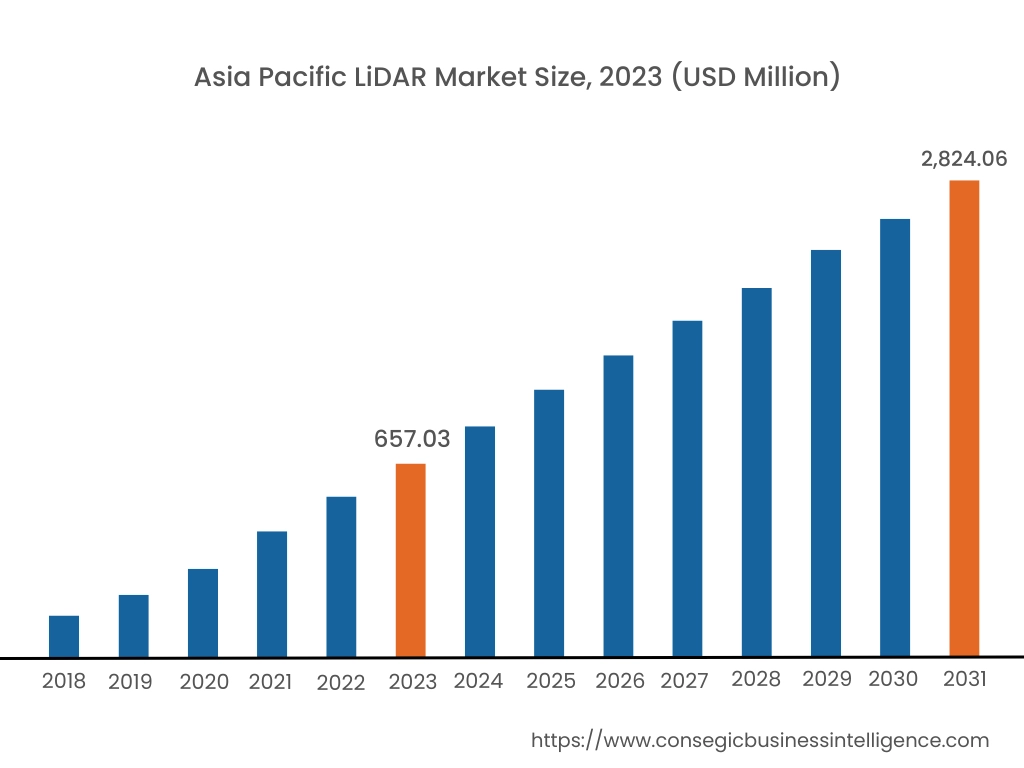
Asia Pacific region was valued at USD 657.03 Million in 2023. Moreover, it is projected to grow by USD 774.69 Million in 2024 and reach over USD 2,824.06 Million by 2031. Out of this, China accounted for the maximum revenue share of 26.4%. The Asia-Pacific region is experiencing rapid growth in the market, driven by expanding infrastructure projects and advancements in technology. Countries such as China, Japan, and South Korea are leading the charge, with increasing investments in urban development, transportation, and environmental monitoring. This dynamic growth is supported by a rising demand for precise and efficient data collection across various sectors, making Asia-Pacific a key area for the LiDAR market expansion.
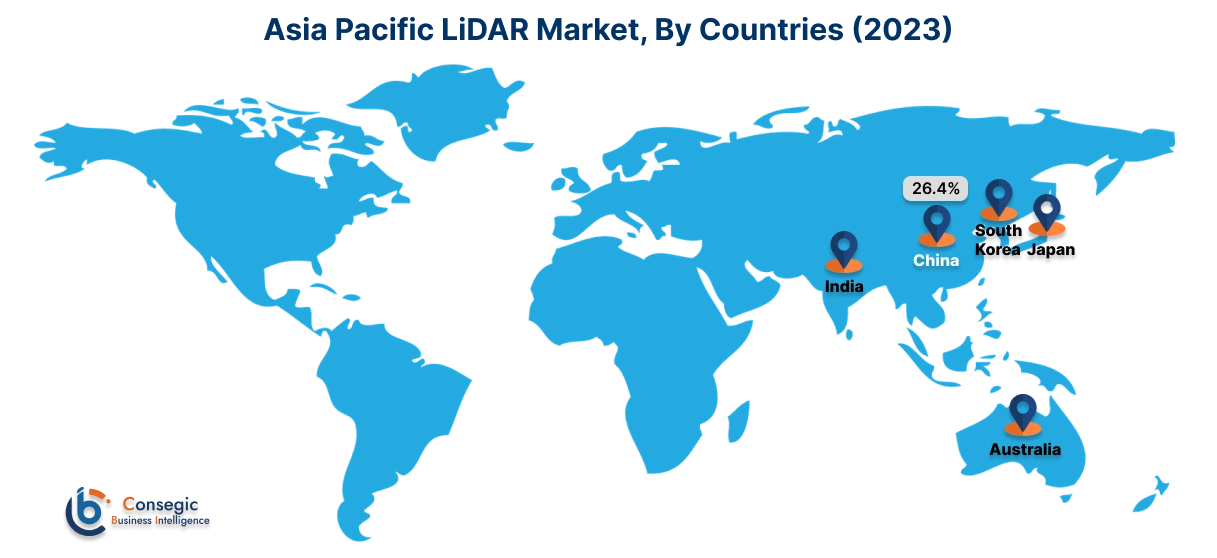
North America is estimated to reach over USD 4,520.38 Million by 2031 from a value of USD 1,106.89 Million in 2023 and is projected to grow by USD 1,299.36 Million in 2024. North America remains a pivotal player in the LiDAR market, driven by its advanced technological infrastructure and substantial investments from major tech and automotive companies. The United States and Canada, in particular, is a hub for innovation, with a strong focus on integrating Li-DAR into autonomous vehicles and smart infrastructure projects.
- In February 2022, applications. This solution enables efficient tracking, monitoring, produce HD maps and 3D models with advanced driver-assistance systems (ADAS) testing.
According to LiDAR market analysis, Europe emphasizes smart city initiatives, environmental monitoring, autonomous vehicles, and precision engineering. Countries including Germany and the UK are at the forefront of deploying LiDAR technology for urban planning and infrastructure development, supported by favorable policies and investments in sustainability.
In Latin America, the market is steadily growing as the region invests in infrastructure and environmental management projects. While the market is still developing there is a noticeable increase in the adoption of LiDAR technology for applications such as urban planning and natural resource management.
The Middle East and Africa are witnessing gradual growth in the LiDAR market, driven by large-scale infrastructure projects and a growing focus on environmental monitoring. The region's investment in smart cities and transportation networks is fueling the demand for advanced Li-DAR solutions.
Top Key Players & Market Share Insights:
The LiDAR market is highly competitive with major players providing precise measurement between objects to the national and international markets. Key players are adopting several strategies in research and development (R&D), product innovation, and end-user launches to hold a strong position in the LiDAR market. Key players in the LiDAR industry include-
- Luminar Technologies, Inc. (US)
- Innoviz Technologies Ltd. (Israel)
- Hexagon AB (Sweden)
- Velodyne Lidar, Inc. (US)
- LeddarTech Inc. (Canada)
- Waymo LLC (US)
- Ouster, Inc. (US)
- NCTech (UK)
- Sick AG (Germany)
- Quanergy Systems, Inc.(US)
- RIEGL Laser Measurement Systems (Austria)
- Topcon Positioning Systems, Inc. (US)
- Leica Geosystems (Switzerland)
- Imec (Belgium)
- Surphaser 3D Scanners (US)
Recent Industry Developments :
Product Launches:
- In August 2024, Aeva launched Aeva Atlas, a 4D Li-DAR sensor designed for mass production of automotive applications. It provides safer advanced driver assistance systems (ADAS) and autonomous driving. It is powered by an Aeva CoreVision Li-DAR-on-Chip Module and Aeva X1 System-on-Chip Processor for seamless data acquisition, point cloud processing, scanning system, and application software.
- In July 2024, Luminar introduced Sentinel, a full-stack software suite with AI capabilities. The software is designed to provide enhanced safety, autonomous functionality on vehicles, 3D mapping, and dynamic Li-DAR features.
- In May 2024, Cepton introduced StudioViz, a proprietary Li-DAR simulation platform. This aims to streamline Li-DAR adoption processes from productization to deployment. Additionally, helps automotive Original Equipment Manufacturers (OEMs) expedite li-dar-based advanced driver assistance systems (ADAS) and autonomous vehicle (AV) development at minimized implementation costs.
Announcement:
- In April 2024, Luminar announced the production of a Li-DAR sensor for Volvo EX90. The company also expanded collaboration with Applied Intuition and TPK to provide substantial industrialization resources to Luminar. The Volvo cars are designed to drive standardization of safety-focused systems.
Collaborations:
- In May 2024, Lumotive collaborated with Hokuyo Automatic to release the YLM-10LX 3D li-dar sensor. It features Lumotive's Light Control Metasurface (LCM) optical beamforming technology and programmable optics to transform 3D sensing across industrial automation and service robotics applications.
- In March 2023, Thale Alenia Space, the partnership between Thales and Leonardo, signed a contract with the European Commission to launch the project known as EuroHAPS (High-Altitude Platform Systems). The project will test a range of missions with observation and categorize targets on land or at sea.
LiDAR Market Report Insights :
| Report Attributes | Report Details |
| Study Timeline | 2018-2031 |
| Market Size in 2031 | USD 11,771.82 Million |
| CAGR (2024-2031) | 19.1% |
| By Component |
|
| By Type |
|
| By Installation |
|
| By Dimension |
|
| By End-User |
|
| By Region |
|
| Key Players |
|
| North America | U.S. Canada Mexico |
| Europe | U.K. Germany France Spain Italy Russia Benelux Rest of Europe |
| APAC | China South Korea Japan India Australia ASEAN Rest of Asia-Pacific |
| Middle East and Africa | GCC Turkey South Africa Rest of MEA |
| LATAM | Brazil Argentina Chile Rest of LATAM |
| Report Coverage |
|
Key Questions Answered in the Report
What is LiDAR? +
LiDAR is an acronym for Light Detection and Ranging is an optical remote sensing technology used to measure distances between objects with high precision. It operates by emitting rapid pulses of laser light toward a target.
How big is the LiDAR market? +
LiDAR Market size is estimated to reach over USD 11,771.82 Million by 2031 from a value of USD 2,915.93 Million in 2023 and is projected to grow by USD 3,419.68 Million in 2024, growing at a CAGR of 19.1% from 2024 to 2031.
What is the key market trend? +
Advancements in 3D LiDAR technology are enhancing data resolution and accuracy, making it more valuable for applications in urban planning, environmental monitoring, and autonomous vehicles.
Who are the major key players in the LiDAR market? +
The major key players in Li-DAR market are Velodyne Lidar, Inc. (US), LeddarTech Inc. (Canada), Waymo LLC (US), Quanergy Systems, Inc. (US), Ouster, Inc. (US), RIEGL Laser Measurement Systems (Austria), Topcon Positioning Systems, Inc. (US), Hexagon AB (Sweden), Innoviz Technologies Ltd. (Israel), Luminar Technologies, Inc. (US), Sick AG (Germany), Leica Geosystems (Switzerland), Imec (Belgium), NCTech (UK), Surphaser 3D Scanners (US) and others.
